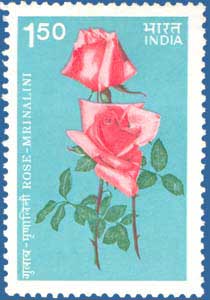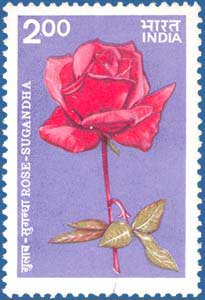
ROSES
This beauteous flower, Rose has a universal appeal. Poets, craftsmen and painters have found joy and inspiration in the range of colours, form, substance and fragrance this exquisite flower offers. While the ancestry of the Rose can be traced to earlier fossil remains, its imposing advent is unmistakably with the advent of Hybrid Tea, celebrated for its classic form and range of colours. Man has taken over from Nature, and the few creations of hybridisers continue to be a source of marvel and delight.
History of roses in India dates back to 334-323 BC when it is reported that Alexander the Great in his epic drive to the borders of India sent one of the newly discovered rose plants bact to his mentor Aristotle and to ancient Greece. Later during the Moghul period too, the legendary gardens of Samarkhand and at the famous monument of Taj Mahal, roses were present. It is to India that the world owes the discovery of ‘otto’ or ‘attar’ of roses. Empress Nur Jahan once noticed an oily film floating on her famous rose bath. This substance was separated and distilled and rose oil or ‘attar’ was discovered.
While, roses have been popular in India, through legend and poetry, in recent times roses of Indian origin introduced by hybridisers in India have attracted attention worldwide. Rose breeding started early in the first half of the century and one of the earliest breeders was Bhattacharji (BS) the well-known nurseryman of Deogarh. Scientific rose breeding on modern lines started during the nineteen sixties at the Indian Agricultural Research Institute (IARI) New Delhi.
There are three popular varieties of modern roses, viz. (i) Hydrid Teas (HT for short) which produce large flowers on single long stems, (ii) Floribundas which produce clusters of medium sized flowers and (iii) Miniatures, which are small and exact replicas of HTs.
In India there are today, over three hundred varieties developed locally, prominent amongst these are ‘Raja Ram Mohan Roy’ (A.M.Bhattacharji 1959) apricot coloured; ‘Sugandha’ again a rich fragrant variety from S.M.Bhattacharji (1964), the pristine pure white ‘Dr. Homi Bhabha’ (Pal 1968); a lovely red and silver ‘Srinivas’ (Kasturirangan 1969), the ‘Banjaran’, a brilliant red and gold (Pal 1969) and many bewitching ones – ‘Bhim’, ‘Jawahar’, ‘Mrinalini’, ‘Mohini’ from IARI.
The varieties selected for the present issue of stamps i.e., ‘MRINALINI’ and ‘SUGANDHA’ are two of the finest examples of roses developed in India. Their brief descriptions are given below:
'MRINALINI' (IARI 1974):

A hybrid seeding from the cross of ‘Pink Parfait’ and ‘Christian Dior’ (HT). Phlox pink, long pointed buds open to very large (10cm diameter across) well-formed blooms on long stem. The flowers are long lasting and borne on vigorous growing bushes (plant height 85 cms) producing about 60 blooms in a season from December to April.
___________________________________________________
SUGANDHA' (Bhattacharji 1964)


Long pointed buds, ranging from pure red to scarlet, opening into large loose flowers on medium tall, upright growing bush. The flowers are gloriously scented and tend to droop. However, flowers on strong shoots attain exhibition quality.
Text Courtesy: Friends of Roses, Bombay and Rose Society of India, New Delhi.
The stamps are based on photographs provided by the Rose Society of India. The first day cover features the roses ‘Raktagandha’. .